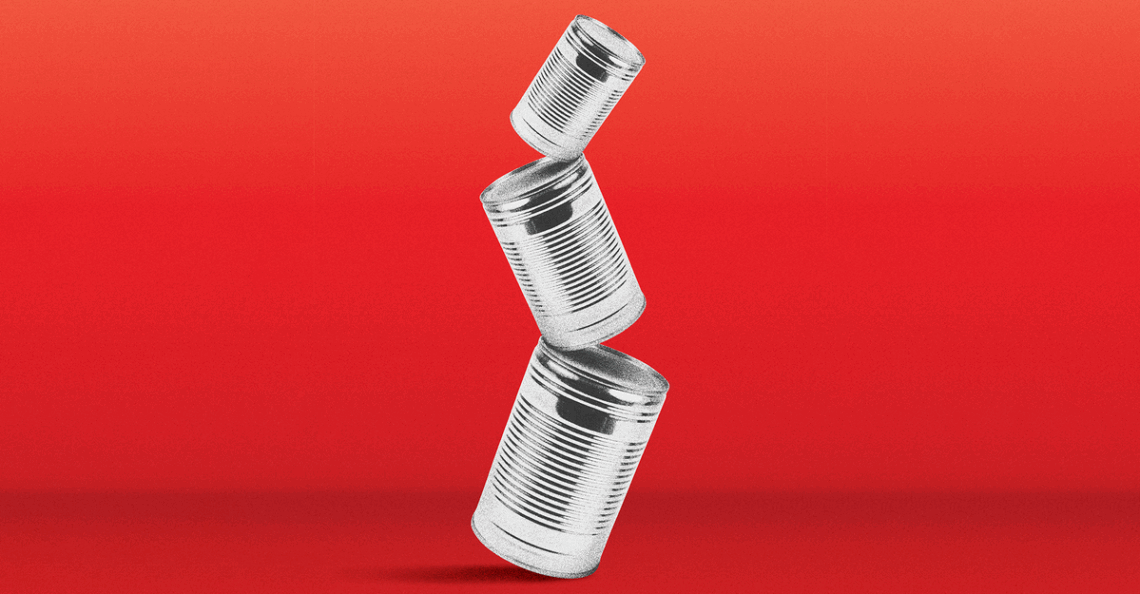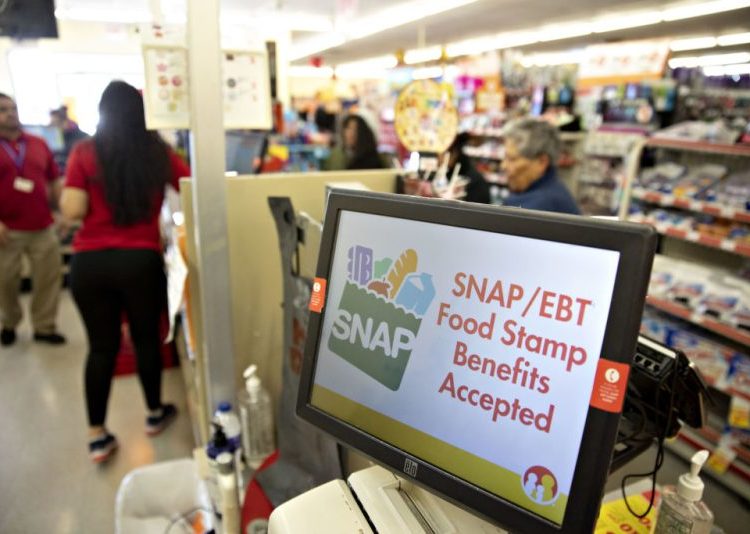During America’s hardest economic times, canned goods were a lifeline. From 1929, the start of the Great Depression, to 1941, when the United States entered World War II, people ate nearly 50 percent more canned fruit, by weight, compared with the preceding 13 years. Some used new community canning centers to safely preserve food for the long term, or depended on the U.S. government’s first food-stamp programs to buy “surplus goods,” including canned beef, mutton, goat, and peas.
Millions of Americans are now bracing for the possibility that the Supplemental Nutrition Assistance Program will run out on November 1—tomorrow. The ongoing government shutdown has frozen funding for SNAP, and as anxiety about hunger mounts, some state agencies have advised SNAP beneficiaries to stock up on canned goods such as beans, soup, fruit, and tuna. Only, those foods aren’t so reliably affordable as they once were, in part because of restrictions on the materials that go into the cans themselves.
Roughly 42 million Americans rely on SNAP for food. This week, a number of Democrat-led states sued the Trump administration for refusing to tap into a $5 billion SNAP emergency reserve. The USDA website blames Democrats, in turn, for the suspension in food assistance. “SNAP benefit recipients wouldn’t have to worry at all if Democrats would stop using them as political ‘leverage,’” Kush Desai, a White House spokesperson, told me. (When I emailed the USDA’s press office, an auto-reply from a spokesperson said they were furloughed and would respond when funding was restored.)
Canned foods have been a lifeline in lean times because they’re long-lasting, generally nutritious, and, most of all, cheaper than their fresh counterparts—largely because the necessary materials could be imported reliably and cheaply. Canning requires a special type of metal called tin-mill steel, which the U.S. imports from Canada, Germany, the United Kingdom, and the Netherlands, Tom Madrecki, vice president of supply-chain resiliency at the Consumer Brands Association, told me. Tin-mill steel is unwieldy and fragile, he said, and less valuable than steel meant for cars and machinery. So U.S. steel manufacturers have deprioritized making it. As a result, the U.S. produces only about 20 percent of the tin-mill steel used by domestic can manufacturers, Scott Breen, the president of the Can Manufacturers Institute, a trade group, told me. “We have no choice but to import the other 80 percent,” he said.
Since Trump’s first term, those imports have been subject to a 25 percent tariff; in June, it rose to 50 percent for steel coming from most countries. Trump’s tariffs are meant to stimulate American manufacturing, but the U.S. is simply not equipped to produce enough tin-mill steel: Since 2018, the nation’s 12 plants have dwindled to three, and there’s no sign of further investment, Breen said. The administration has not yet heeded the canning industry’s calls for a tariff exemption on tin-mill steel. Trade negotiations with Canada, which involved metal tariffs, recently disintegrated. (The U.S. also imports roughly $2 billion worth of canned food a year, Breen said—about 10 percent of the national supply. According to the Can Manufacturers Institute, nearly a quarter of that food comes from China, which negotiated a 47 percent average tariff on imports that Trump announced yesterday morning.)
The price of tin-mill steel has never been higher, Madrecki said. Canned-food manufacturers have been passing the extra cost to retailers and, inevitably, consumers. From September 2024 to September 2025, the average consumer price of canned fruits and vegetables rose by 5 percent, nearly double the increase observed in food in general, according to government data. Over time, a 50 percent tariff on tin-mill steel could raise the sticker price of canned foods by as much as 15 percent, according to a June analysis by the Consumer Brands Association.
That increase is a matter of cents per can, but it does add up quickly. “It’s really hitting the lower-income customers that rely on SNAP benefits,” Usha Haley, an international-business professor at Wichita State University, told me. In an average week, a SNAP beneficiary eats seven cans of food, according to the Can Manufacturers Institute. (Those who don’t use SNAP consume about five.) With a 15 percent price increase, the same amount of money that beneficiary spends would cover only six cans. “At the end of the day, you put one fewer can in your cart,” Madrecki said.
The government itself has been affected, too. One of the biggest purchasers of canned goods is the USDA, Madrecki told me, which uses them to supply food to prisoners, for school meals, and to the Women, Infants, and Children program. By raising tariffs, “the government is increasing its own prices,” Breen said.
State governments have encouraged families to continue to gather shelf-stable foods at food banks if the SNAP benefits stop coming. But charitable food organizations are already strained: Rising food costs due to inflation have driven more people to seek donated items. The implications of taking SNAP away will be “catastrophic” for food banks, Ami McReynolds, interim chief of government relations at Feeding America, told me. Plus, some of the goods such centers stock are donated, but the rest are purchased wholesale by the organizations that run them. “The prices go up for them as well,” Breen said. (Several states have announced plans to send more money to food banks next month.)
Most families spend all of their SNAP credits within three weeks of receiving them at the beginning of each month, Joel Berg, the CEO of the nonprofit Hunger Free America, told me. Those who want to follow states’ guidance to stock up now, before a SNAP cliff, most likely don’t have anything left to budget. Families who can’t afford as much canned food as they normally buy now have limited alternatives for supplementing their diet: Delaware’s suggestions for shelf-stable foods include cereal, oatmeal, peanut butter, nuts, applesauce, pasta, and granola bars—hardly a filling or nutritious diet. A can of beans for protein, or canned pears for fiber, could turn a bowl of carbohydrates into a healthier and more satisfying, if still meager, meal.
Modern-day hunger isn’t as stark as it was during the Depression: In 1933, a New Yorker died every 12 days from hunger, according to The New York Times, and many more Americans developed illnesses associated with malnutrition. Today, when budgets run low, people tend to reduce portion size, skip meals, or buy less healthy food; they generally don’t go long periods without eating, Berg told me. But if the first few days of November pass without the restoration of SNAP benefits, he said, “you’re going to start seeing, for the first time in modern American history, large amounts of Americans going without any food at all.”
The post The Price of Canned Food Is Creeping Up appeared first on The Atlantic.




